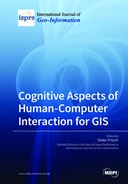Explore

Cognitive Aspects of Human-Computer Interaction for GIS
Dieter Fritsch
2019
0 Ungluers have
Faved this Work
Login to Fave
The book is dealing with recent progress in human–computer interaction (HCI) related to geographic information science (GIS). The Editorial starts with an overview about the evolution of the Internet and first HCI concepts and stimulates recent HCI developments using 3D and 4D apps, running on all mobile devices with OS Android, iOS, Linus, and Windows. Eight research articles present the state-of-the-art in HCI–GIS-related issues, starting with gender and age differences in using indoor maps via the estimation of building heights from space to an efficient visualization method for polygonal data with dynamic simplification. The review article deals with progress and challenges on entity alignment of geographic knowledge bases.
This book is included in DOAB.
Why read this book? Have your say.
You must be logged in to comment.
Rights Information
Are you the author or publisher of this work? If so, you can claim it as yours by registering as an Unglue.it rights holder.Downloads
This work has been downloaded 254 times via unglue.it ebook links.
- 71 - pdf (CC BY-NC-ND) at Unglue.it.
Keywords
- 3D data cube
- 3D geovisualizations
- 3D map
- 3DmoveR
- 4D time density
- age effects
- building tracking
- cartographic simplification
- Cloud computing
- collaborative immersive virtual environment
- collaborative learning
- Computer science
- Computing & information technology
- contour lines
- cyberpsychology
- entity alignment
- Eye-tracking
- gender effects
- geographic knowledge bases
- Geospatial data
- Head-mounted display
- hedonic price model
- height estimate
- high definition video
- human–computer interaction
- hypsography
- Immersion
- immersive virtual reality
- indoor wayfinding
- International Space Station (ISS)
- knowledge conflation
- Knowledge Integration
- level of interactivity
- level-of-detail rendering
- Ljubljana
- map literacy
- map tasks
- map users
- movement data
- multiresolution segmentation
- n/a
- OLS
- OSIVQ
- PCA
- PR-Tree
- random forest
- retrospective verbal protocol
- sense of presence
- similarity combination
- similarity metrics
- space use intensity
- spatial data processing
- SpatialHadoop
- spatiotemporal movement patterns
- telepresence
- tessellation
- trajectory datasets
- trapezoid
- user study
- user’s performance
- vector polygon
- visual data exploration
Links
DOI: 10.3390/books978-3-03921-569-0Editions


